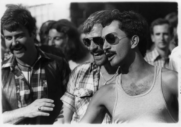
This must-see documentary from 1997 was produced by San Francisco’ s KQED-TV as part of a series “Neighborhoods: The Hidden Cities of San Francisco”. It’s a fascinating investigation on how The Castro became the gay holy grail.
The area was originally known as the Eureka Valley when it was full of dairy farms until Irish immigrants moved in and built tall Victorian homes to house their large extended families. As it became more built up Irish Bars appeared and on every single block, and the community focused around the Church of the Holy Redeemer .
 They were always homosexuals in the city but back in the 1950’s it was not only illegal just to be caught having a drink together in the bar, but just like in NY, the Police were very fond of rounding up as many gay man and women as they could. Their arrests would be published in the local newspapers who would also print home addresses and the name of employers. This ‘Lavender Scare‘ ruined many gay people’s lives and often drove them to suicide.
They were always homosexuals in the city but back in the 1950’s it was not only illegal just to be caught having a drink together in the bar, but just like in NY, the Police were very fond of rounding up as many gay man and women as they could. Their arrests would be published in the local newspapers who would also print home addresses and the name of employers. This ‘Lavender Scare‘ ruined many gay people’s lives and often drove them to suicide.
However the GI Bill and the arrival of automobiles suddenly made all the Irish residents very mobile, and one after another, they moved to brand new houses in the suburbs. As their large victorian mansions started to fall into disrepair the gays slowed moved into the area and started to gentrify the place. It all co-included with new feeling of freedom in the 1960’s when the local gays came out of the closet and gradually became a community where they could their true selves at last.
In the 1970’s the ‘party’ really took off with every man ‘cloned’ to look the same as all the other buff men, dancing to the disco star Sylvester, and even having the gall to close the whole street  down to hold parades,. Then just like it felt that the Community was discovering finding its collective voice by electing Harvey Milk as the first gay City Supervisor , it all came tumbling down.
down to hold parades,. Then just like it felt that the Community was discovering finding its collective voice by electing Harvey Milk as the first gay City Supervisor , it all came tumbling down.
When Milk was murdered it seemed like the whole city turned out spontaneously in the candlelight memorial march publicly showing the strength of the community. However when Milk’s killer was let off lightly a large gay crowd expressed their anger by burning police cars outside City Hall. It resulted in a wholesale invasion of The Castro by an enormous police force who went down the entire street beating up everybody they could find, and even going into Bars to do the same .
This was 1976 and it didn’t give the area time to move on before the AIDS pandemic hit and completely decimate the community. Even now it is still impossible to comprehend how the disease that devastated the whole world seemed to have reeked the most unthinkable havoc on San Francisco and in particular The Castro.
Not everyone thought the Castro was a gay mecca. At the beginning it was very white and male. The lesbians were only really welcomed beyond the few bars that catered to them once AIDS hit hard and they became care givers and support systems. Also after it became such a sought after area in the 1970’s property prices soared pricing out so many people who could no longer afford the rents, especially young gay men and women.
The documentary has some excellent archival footage which is woven in with interviews from locals such as Cleve Jones, Del Martin and Phyllis Lyon plus Walter Park, a gay housing activist who raised his young daughter Felicia Park-Rogers there throughout the 1970’s and -80’s
As the documentary outlines all the numerous re-births of this important gay capital, not everyone agreed that all progress was perfect. One interviewee that moved to the area in the 1970’s complained he was one of the few black people there , and now in nineties he still had complaints,. However he added that he was still so committed to the place he still couldnt/wouldnt leave,
Most gay men (at least those of a certain age) feel that need to make the mecca to The Castro at least once in their lives.. Some still feel the need to stay for ever once then get that first drink at the Twin Peaks Bar. Then there are those who still live there, and consider themselves lucky survivors. Add to this are members of our community who are too young to be touched by some of traumas that The Castro has been through.
For all these people this doc is real must see so we can truly appreciate why The Castro was, and still is, so important to teh whole LGBTQ Communiy.

